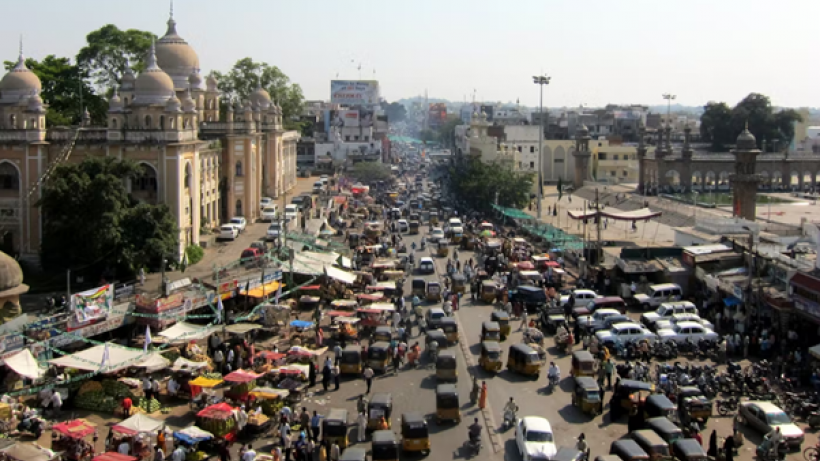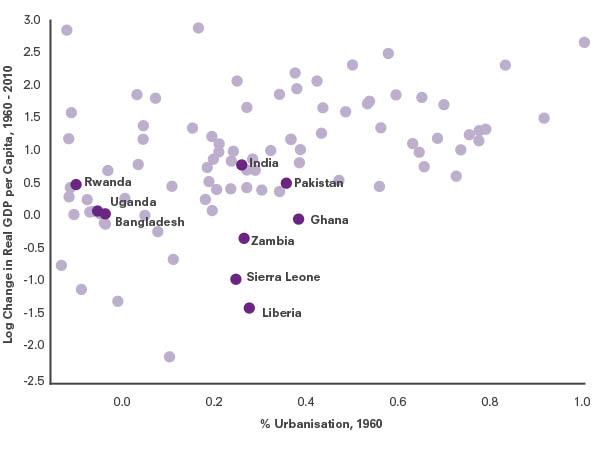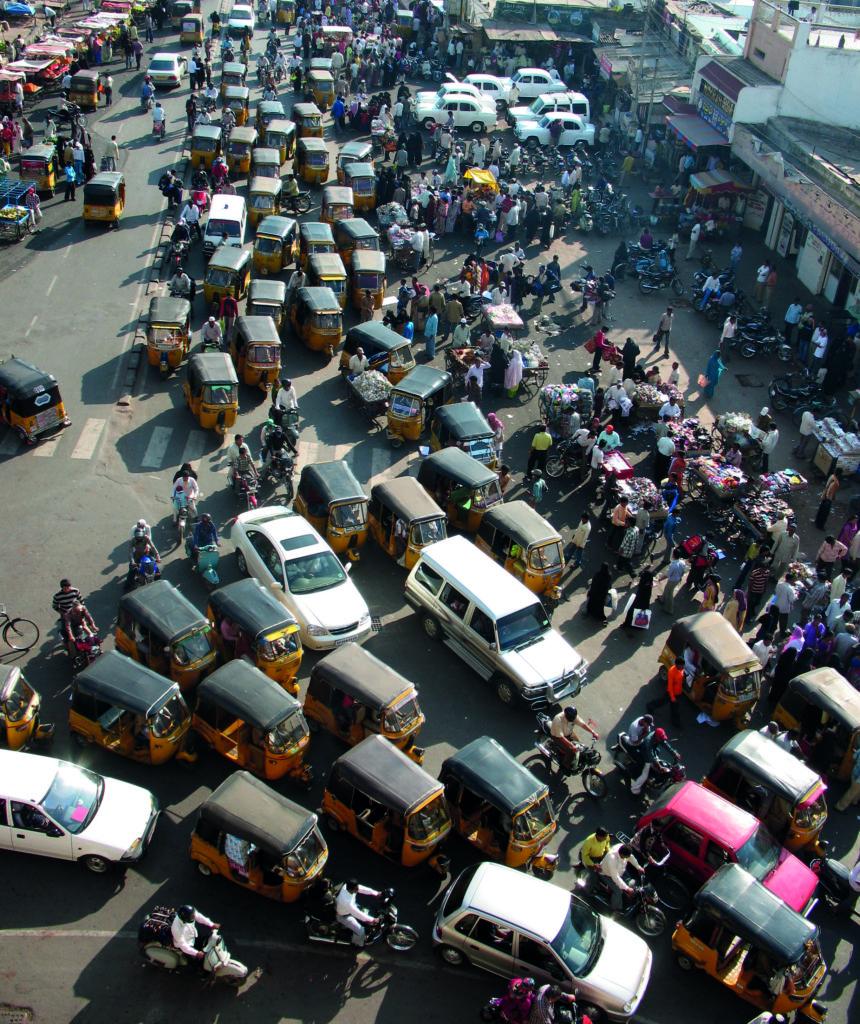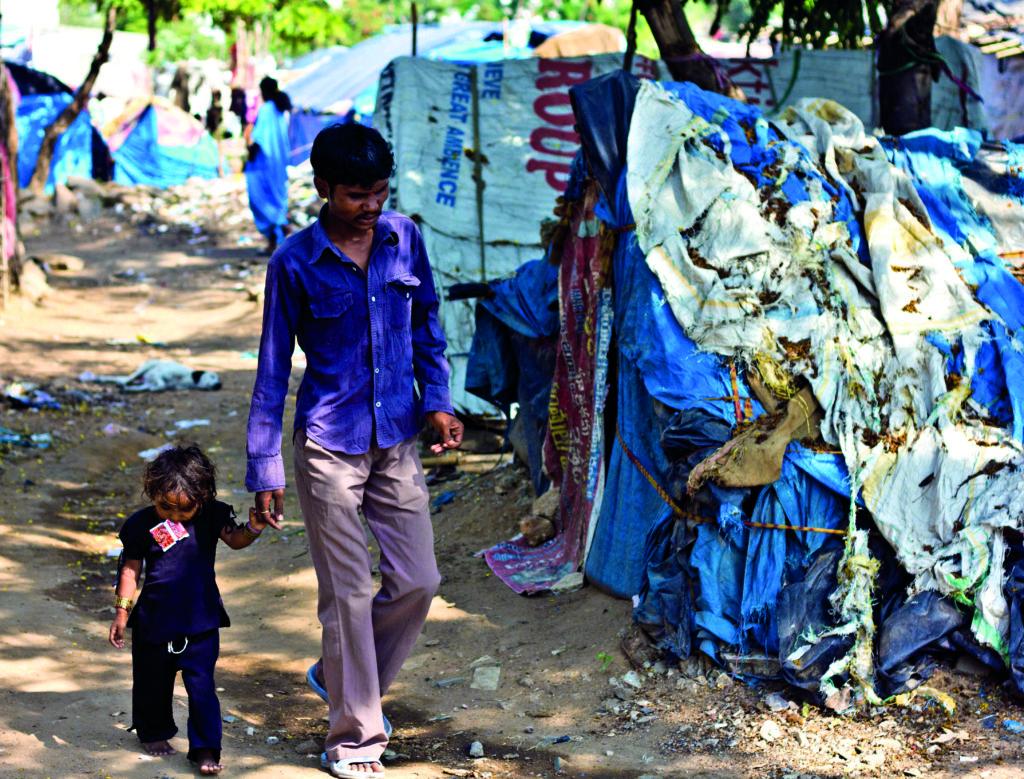
Growth brief: Contagion, crime, and congestion - overcoming the downsides of density
With rapid urbanisation in the developing world comes contagion, crime, and congestion. Overcoming these is one of the great policy challenges of the 21st century.
-
Glaeser-Sims-2015-Growth-brief.pdf
PDF document • 577.59 KB
Introduction
This brief outlines why these issues are so important to the prosperity of cities and discusses ways to tackle them, providing useful lessons for policymakers. It also identifies opportunities for economists to get engaged in the field of urbanisation studies in developing countries.
KEY MESSAGES
1) Cities and urbanisation encourage economic growth in the developing world
The relationship between urbanisation and income is stronger today than it was in 1960, reflecting the positive effect that increased density can have on cities worldwide. In addition, cities encourage national economic growth and improved governance.
2) Contagion, crime, and congestion are important challenges, yet they are often poorly managed and understood
However, cities cannot avoid the downsides that come from density – contagion, crime, and congestion. Public investments in these areas are costly and hard to manage, especially as urban governments are often under-resourced and plagued by inefficiencies. There is therefore a need for economists to closely study these issues in developing countries.
3) We also need to understand and encourage one of the benefits of urbanisation – upward mobility out of city slums
On the contrary, upward mobility is the the potential of urbanisation to lift people out of poverty by delivering higher earnings and a better quality of life, especially when compared with the rural alternative. It is important to understand how cities deliver prosperity by gathering data and by testing low-cost interventions to encourage upward mobility.
Across the world, developing countries are urbanising at impressive rates and this trend is set to continue. Urbanisation is essential for these countries to move from poverty to prosperity. Yet one cannot ignore the considerable downsides that come with this increased density – notably contagion, crime, and congestion. Most cities have suffered from at least one of these problems in recent years; some places suffer regularly from all three. Tackling these are some of the primary challenges of urban government today. To tackle these downsides, well-functioning urban governments must commit massive amounts of expenditure. However, today, mega-cities are emerging in places that are both poor and poorly governed. These constraints make it particularly difficult to solve urban problems and mean that the approaches used by developed countries cannot be facilely imitated. While the aforementioned “downsides of density” can be terrible in and of themselves, they carry an additional cost. They seem to provide a coherent rationale for why the growth of cities in the developing world should be limited. That conclusion is incorrect. The millions of migrants who come to cities, despite their problems, remind us of the bleak future presented by rural poverty. The right conclusion is that the world needs to make its poorer cities better places, and research is a critical part of that task.
Key message 1 – Cities and urbanisation encourage economic growth in the developing world
Over the last fifty years, urbanisation has increased rapidly in developing countries, and this trend is set to continue. By 2030, the developing world’s urban centres are expected to absorb 96 percent of the additional 1.4 billion people that will be added to the world’s population. The last fifty years have shown a strong correlation between urbanisation and income (GDP per capita), as evidenced by Figure 1. Nine countries where IGC works have been highlighted showing a similar upward trend. This outcome reflects the effect of increased density, rather than the idea that cities attract more talented people (Combes et al 2010).
Yet there is also no avoiding the downsides that come from density. So often, urbanisation has led to contagious diseases, crime, and congestion. This is not inevitable. If well managed, cities can be places of health and safety. But the high quality of life that permeates wealthy cities does not come cheaply. Urban infrastructure, from sewers to subways, is notoriously expensive and must be properly sequenced. Policing public spaces is also costly. Developing country cities are trying to solve protracted urban problems without enough resources.
Moreover, the provision of public services becomes even harder if public institutions are weak. Policing can become ineffective if the police are corrupt. Infrastructure can go wrong in many ways, from the routine corruption of overpaying for supplies and labour, to the massive misdirection of projects towards politically favoured constituents. Global history is replete with examples of waste and corruption in urban government.
However, there are reasons to be hopeful about developing country urbanisation, even when their cities appear dysfunctional. It is far easier to imagine economic growth coming to these cities than to subsistence farmers. It is far more plausible that the citizens of these cities will effectively organise for political change and improved governance. It is far more likely that participatory governance will occur in urbanised countries. To reap these benefits, policymakers must tackle these “downsides of density”, supported by research findings applicable to local contexts.
Figure 1: The impact of urbanisation on GDP

1 Bangladesh, Ghana, India, Liberia, Pakistan, Rwanda, Sierra Leone, Uganda and Zambia.
Key message 2 – Contagion, crime, and congestion are important challenges, yet they are often poorly managed and understood
This brief highlights three downsides of density which affect all global cities – contagion, crime, and congestion. These sections will identify options for policymakers while outlining some of the biggest outstanding research questions.
Contagion
Water and sewers are the most basic functions of urban government. While urbanisation without clean water and amidst refuse has, and does, occur, the health consequences are evident. The standard view is that the low life expectancy associated with city living prior to 1900 is largely a reflection of poor sanitation. The OECD has estimated that approximately 10% of the global burden of disease worldwide could be prevented with improvements to water, sanitation and hygiene, and better water resource management worldwide (OECD 2001). The larger issue is how to provide water and sewerage systems, and how much to spend. Even the most ardent believer in sewers might balk at spending $2,000 per household on waterworks in a country where per capita incomes are below $400 per year. The need for evaluation of spending and innovative implementation explains why economists, not just engineers and public health experts, need to play a role in researching sanitation investments.
Research agenda
• Infrastructure substitutes: The easiest and cheapest substitute for water infrastructure is the provision of chlorine tablets at the point of water consumption. Kremer et al (2009) have found remarkable results with low cost interventions in rural Kenya. It isn’t entirely obvious that this translates perfectly into urban areas, or that it is a substitute for sewers. Developing country cities would benefit from high quality research on randomised water related interventions that do not require expensive infrastructure.
• Impact on health and the economy: If countries and aid agencies are going to make sensible decisions about how to invest in water, it seems crucial to quantify the size of the impacts on health and the wider economy. Does investing in water mains make sense if chlorine tablets are available, or should funding be targeted towards early childhood education? Without better estimates of the costs of poor water quality, we cannot answer that question.
• The provision and funding of infrastructure: Should water infrastructure be built by a public entity or a public-private partnership? Today, about 7 percent of the urban population in the developing world is served by private operators, a model backed by the World Bank (Marin 2009). Yet doubts remain about the merits of this approach. No model is likely to be perfect in countries where institutional quality is weak and varies in form, but understanding the trade-offs between different institutional models is important.
• Funding: In developed countries, water companies were assured of profits because they enjoyed a monopoly on water provision. Alternatives such as bore holes and wells were outlawed in many high density areas. Many developing countries have not addressed traditional methods of dealing with water and sewage. How does this change the appropriate institutional design for water provision?
Sewers and water pipes may not be the most glamorous aspects of urban life, but they are among the most important parts of a city. Economists have under-invested in sanitation research for decades, because these topics did not seem relevant to developed cities. As developing country cities grow, the need to revisit the battle for clean water becomes more urgent.
Crime
Crime has the capacity to yield direct welfare losses, but also to negatively impact investment activity, tourism and urban street life. Yet any serious analysis of crime in the developing world has to start with the recognition that city policing is far from reliable. The knee jerk reaction – hire more police and lock more people up in prison – may not be successful if the police are corrupt or ineffective.
An important consideration is that urban public safety has historically relied on private, not public, crime prevention, described by Jane Jacobs as the “eyes on the street” (Jacobs 1961). It is arguable that much of the differences in crime rates across the developing world have little to do with formal policing and much to do with neighbourhood crime prevention and the incentives to engage in criminal activity. Mumbai’s slums are much safer than Rio’s favelas, but not because the Mumbai constabulary is more effective than the Rio police. Some combination of neighbourhood cohesion and the returns to violence in the drug trade seems the likelier explanation.
The community’s role should be complemented with a public presence. Effective police forces often excel in leveraging the assets of the neighbourhood and getting residents to be their informants. For example, the Community Liaison Officer (CLO) system in Uganda seems to have strengthened links between the police and the communities they serve and encouraged NGOs to work on community safety and decreased domestic violence (Tindifa and Kiguli 1997). Given these potential outcomes, community policing and other police initiatives deserve more attention, as discussed below.
Research agenda
• Data: In developed countries, researchers are typically comfortable using reported crimes, although they understand that under-reporting is a real issue. In the developing world, under-reporting is typically thought to be so enormous that victimisation surveys are crucial, unless the researchers focus only on the rare, but well-reported, crime of murder.
• Corruption: Many countries attempt to reduce crime by merely increasing spending on policing. Yet the pervasiveness of corruption can frustrate any attempts to exact change. However, there are opportunities for other interventions. For example, improving the incentives for police to actually fight crime (or reduce the level of extortion by police reported in victimisation surveys) might have significant impacts on safety. In Rajasthan, Banerjee et al (2012) found that the promise of a transfer out of a less favoured assignment based on good performance more than doubled the number of drink drivers brought to court.
• Factors that influence crime: There is a need to understand all of the factors which can influence crime, especially those that have nothing to do with policing. For example, there is long standing debate about the connection between unemployment and crime. Education, especially early childhood education, has also been found to reduce crime (Yoshikawa 1995). Even the introduction of debit cards as cash substitutes have been found to reduce the amount of criminal activity (Wright et al 2014).
• Impact of crime: Finally, it is important to measure the benefits of spending public money to reduce the level of crime. What does crime do to economic activity in developing world cities? There are sophisticated studies of the link between crime and property values in wealthier cities, for example, Gibbons (2003) shows that a 10 percent reduction in recorded crime adds around 1.7 percent to the selling price of a home in London. However there are few equivalent studies in developing countries.
Congestion
While contagion and crime affect most cities to some degree, congestion is a problem everywhere. London and New York have traffic jams that can be just as severe as those in Delhi and Lagos. Indeed, without proper management, traffic problems can easily get worse as incomes rise because a greater fraction of the population is able to afford motor vehicles.
The public sector always plays two significant roles in transportation, and usually takes on a third: 1) managing, or directly providing, transportation-related infrastructure; 2) implicitly or explicitly setting the rules of using that infrastructure, including any prices that are charged; and 3) usually but not always, providing public transit services that use that infrastructure.
Transportation infrastructure normally begins with a street plan, and the setting aside of some space as public thoroughfares. Such a plan costs little and has strong benefits. Paul Romer has argued that developing country cities should adopt grids and protect streets from private development even if the city is unprepared to invest in the infrastructure that surrounds the streets. Yet protecting a grid will be extremely difficult in many developing country cities. If the movement towards street planning becomes stronger, there will be a role for economists to play in evaluating different plans for protecting public spaces against private encroachment.
Infrastructure that goes beyond the grid becomes more debatable. The most basic step is paving for automotive and pedestrian paths. But how much space should be allocated for pedestrian use relative to cars? Developing country cities differ significantly in the pedestrian space that they have made available. For example, walking around the streets of Lusaka is quite easy, while walking around much of Mumbai is considerably more challenging. It may be tempting to argue that all dense cities need decent sidewalks, but since many do not have them, even research on such a basic question would have some value.
Beyond paving comes highways and then elevated or submerged transport links, including subways and bridges. These investments can be very expensive and it is important that we understand the benefits as well as the costs. Traditional analysis has focused on the direct benefits to riders. While still important, a new and exciting literature is looking at the ways in which transportation is shaping local economies. These papers typically compare cities with rail or highway linkages to cities without similar infrastructure. The big challenge is how to prove that transportation investments were not correlated with other factors that influence local economic success.
The impact of transport links on economic success
Two of the best papers that use metropolitan area differences in highway building are Baum-Snow (2007) and Duranton et al (2013). Baum-Snow (2007) convincingly shows that post-World War II highway construction in the United States led to increased suburbanisation and depopulation of the central city. This paper reminds us that there can be geographic losers from transportation investment. Valparaiso, Chile, for example, famously shrank hugely after the opening of the Panama Canal rerouted ocean traffic.
Duranton et al (2013) also makes an important point: vehicle miles travelled increase almost one-for-one with highway miles built. They are essentially confirming a behavioural response to new infrastructure that had long been suspected. If a country builds more highways, they will get more drivers. If the effect is literally one-for-one, then new infrastructure has done nothing to reduce congestion, but merely managed to put more drivers on the road.
Research agenda
• Congestion pricing: With car-related transportation infrastructure, the point is to reduce congestion by providing more space. Yet the world’s traffic jams show that building more roads merely encourages drivers to drive more, given they aren’t being charged for the social costs of their actions. In response, the economist William Vickrey implemented congestion pricing, an intervention that may be easier when fewer people are used to driving for free. This suggests that it might be appropriate to begin doing experiments with congestion pricing in developing country cities. Naturally this will involve a host of issues surrounding enforcement which may be quite difficult in areas with weak institutions.
• Buses: They are cheap and flexible, which is important in places where future development is unpredictable. Yet the economics literature on buses is quite limited. In many developing country cities, there is a debate between privately run jitneys versus public buses. There is also a question of appropriate subsidies.
• Trains: Trains are the biggest and most expensive form of transportation. They can become a lifeline for a city, as they can provide the one means of getting around when streets become hyper-crowded. Yet Meyer et al (1965) argued that there wasn’t much that you could do with a train that you couldn’t do with a bus on a dedicated lane or tunnel, and the bus would cost much less.
• Metro: Many developing world cities have invested significantly in metro systems. Yet rarely have the results been properly evaluated. Given the vast sums involved, this is also an area that could use more research.
• Linking transportation infrastructure to wider objectives: What is the economic impact of investment in subways or highways? What is the health impact? What do different transportation systems do to the shape of urban society? While there is an abundance of hypotheses, there are few hard facts.

Key message 3 – We also need to understand and encourage one of the benefits of urbanisation – upward mobility out of city slums
Upward mobility is the flip side of the issues discussed so far. It is the potential benefit of urban living. To understand the functioning of developing country cities, it is particularly crucial to get a better grasp of the dynamics of poverty in these areas. Are they producing permanent slum dwellers or is there some upward trajectory? Since the relevant alternative for most slum dwellers is rural poverty, it seems important to compare urban income dynamics with those in non-urban areas. Glaeser and Mare (2001) document that urbanites in the U.S. experience faster wage growth than residents of smaller towns, and De la Roca and Puga (2013) show the same holds for Spain. These facts are compatible with the view that cities can be forces of human capital. Yet there is little work on earnings dynamics in the developing world today. Indeed, researchers are only just starting to put together a decent statistical snap shot of economic life in the slums (Banerjee and Duflo 2007).
The first task is therefore measurement. The difficulty is that data is hard to come by in most urban slums and official data sources are often quite limited in quality. Researchers need to be able to obtain accurate income figures from slum dwellers.
The second task is to look at engaging in areas, like early childhood training, that could potentially make a difference to upward mobility. These projects need to be relatively low cost, so that they can be applied to a large number of people, and rigorously evaluated. These actions will shine a light on the slums and chart the way forward.
The slums of Hyderabad
Hyderabad is the capital of the southern Indian state of Telangana and houses about 6.8 million people, making it the fourth most populous city in India. However, according to a recent census, one third of the population of Hyderabad live in vast slums. This figure is also rapidly increasing – the 2011 census found a 264% increase in slum dwellers since 2001. Experts attribute the high slum concentration to increasing rural migration for work and a lack of effective urban planning. Policymakers need to urgently address the minimal housing options available to recent urbanites from backward regions if they are to ensure the development of all citizens of Hyderabad.

Policy recommendations
Cities are one of the primary sources of economic growth in the developing world. But the downsides of density addressed above – congestion, crime, and contagion – require active management by policymakers. In addition, developing country cities are such a new phenomenon that the need for research is critical and the upside of new knowledge is enormous. With this joint role in mind, policymakers and researchers should address the following issues:
POLICYMAKERS
- Urbanisation does have its downsides. However, these downsides do not, and should not, provide a justification for curbing the growth of cities. Cities and urbanisation are key to stimulating economic growth in the developing world. Instead, issues such as contagion, crime, and congestion require a greater focus by policymakers and researchers alike.
- The provision of public services to combat these downsides can be both costly and difficult to implement. These issues are amplified in developing countries by institutional corruption and a lack of funding. Tackling these issues is key to being able to achieve effective service delivery.
- In the absence of funding for expensive water infrastructure, substitutes (such as chlorine tablets) and alternate funding models become even more important. Research needs to inform policymakers of the best use of limited public funds to sustainably improve sanitation, especially in slums.
- Given the problems of under-reporting and corruption in crime prevention, policymakers should instead focus on ways to incentivise police officers to actually fight crime. In addition, policymakers should focus on alternative ways to reduce crime, for example, by investing in early childhood education.
- Interventions to reduce inner-city congestion need to be better understood, but policymakers should investigate the introduction of congestion pricing, as well as analysing the trade-offs between buses, trains and metro systems.
- Policymakers need to obtain, through decent data, a snapshot of the impact of cities and urbanisation on earnings. It is particularly important to understand whether economic forces are moving slum dwellers out of poverty and into prosperity.
RESEARCHERS
This brief has discussed a number of areas that would benefit from further research with a focus on developing countries:
Contagion
- Viable substitutes (such as chlorine tablets) in lieu of expensive traditional water infrastructure.
- The impact of poor water quality on health and the economy.
- Trade-offs between using public providers, private providers, and/or public-private partnerships to build water infrastructure.
- How to ensure that water provision is profitable and sustainable.
Crime
- How to improve the data collection of reported crime, and to ensure it’s reliable.
- Efforts to reduce police corruption and incentivise reporting of crimes.
- Analysing which anti-crime measures can influence future crime rates e.g. education.
- How crime impacts the economic activity of a developing country city.
Congestion
- The efficacy of introducing congestion pricing.
- A cost/benefit analysis that looks at the economic impact of buses, trains and/or metro systems.
- How the provision of transport systems impacts other economic objectives e.g. health, urban development, migration.
While research is undoubtedly needed, some government action is also needed to deal with externalities such as urban waste and to protect citizens from crime. Therefore, any research must be sensitive to local conditions and pay attention to institutional design. Finally, if researchers are analysing infrastructure provision, coordination and cooperation with relevant government entities is crucial.
References
Banerjee, A., Chattopadhyay, R., Duflo, E., Keniston, D, and N. Singh (2012) “Improving Police Performance in Rajasthan, India: Experimental Evidence on Incentives, Managerial Autonomy and Training” NBER Working Paper No. 17912. Available from: www.nber.org/papers/w17912
Banerjee, A, and E. Duflo (2007) “The Economic Lives of the Poor” Journal of Economic Perspectives, 21(1): 141–167.
Baum-Snow, N (2007) “Did Highways Cause Suburbanization?” Quarterly Journal of Economics, 122(2): 775–805.
Combes, P., Duranton, G, and L. Gobillon (2010) “The identification of agglomeration economies” Journal of Economic Geography, 11(2): 253–266.
De la Roca, J, and D. Puga (2013) “Learning by Working in Big Cities” CEMFI Working Paper No. 1301. Available from: www.cemfi.es/ftp/wp/1301.pdf
Duranton, G., Morrow, P, and M. Turner (2013) “Roads and Trade: Evidence from the US” CEPR Discussion Paper 9393. Available from: www. cepr.org/active/publications/discussion_papers/ dp.php?dpno=9393
Gibbons, S (2003) “The Costs of Urban Property Crime” The Economic Journal, 114(499): F441-F463.
Glaeser, E, and D. Mare (2001) “Cities and Skills” Journal of Labor Economics, 19(2): 316–342.
Jacobs, J (1961) “The Death and Life of Great American Cities” New York: Random House.
Kremer, M., Miguel, E., Mullainathan, S., Null, C, and A. Zwane (2009) “Social Engineering: Evidence from a Suite of Take-Up Experiments in Kenya” Working Paper, Harvard University. Available from: http://environment.harvard.edu/sites/default/files/ WG_chlorinedispensers_social%20engineering%20 april2011.pdf
Marin, P (2009) “Public-Private Partnerships for Urban Water Utilities: A Review of Experiences in Developing Countries” Washington DC: World Bank.
Meyer, R., Kain, F, and M. Wohl (1965) “The Urban Transportation Problem” Harvard University Press. OECD (2001) “Benefits of Investing in Water and Sanitation: An OECD perspective” OECD. Available from: www.oecd.org/berlin/47630231.pdf
Tindifa, S. B, and J. Kiguli (1997) “Community policing study report” Nairobi: The Department for International Development (DFID).
Wright, R., Tekin, E., Topalli, V., McClellan, C., Dickinson, T, and R. Rosenfeld (2014) “Less Cash, Less Crime: Evidence from the Electronic Benefit Transfer Program” NBER Working Paper No. 19996. Available from: http://nber.org/papers/w19996
Yoshikawa, H (1995) “Long-Term Effects of Early Childhood Programs on Social Outcomes and Delinquency” The Future of Children, 5(3): 51–75.
About the authors
Ed Glaeser is a Research Programme Director for the IGC’s Cities Research Programme. He is the Fred and Eleanor Glimp Professor of Economics at Harvard University, where he also serves as Director of the Taubman Center for State and Local Government and the Rappaport Institute for Greater Boston. He also edits The Quarterly Journal of Economics. He studies the economics of cities, and has written several papers on urban issues, including the growth of cities, segregation, crime and housing markets. He received his BA in Economics from Princeton University and his PhD from the University of Chicago (1992). In 2011, Glaeser published a book, Triumph of the City: How Our Greatest Invention Makes Us Richer, Smarter, Greener, Healthier and Happier which was shortlisted for the Financial Times and Goldman Sachs Business Book of the Year Award.
Helen Sims was the Policy Communications Manager at the IGC. She holds an MSc in Africa and International Development from The University of Edinburgh, an LLB and a BA (Public Policy and International Relations) from Victoria University of Wellington. Prior to undertaking her masters, she worked in policy development for the New Zealand Ministry of Education, as well as being involved with NGO’s in Kenya, Uganda and the UK.



